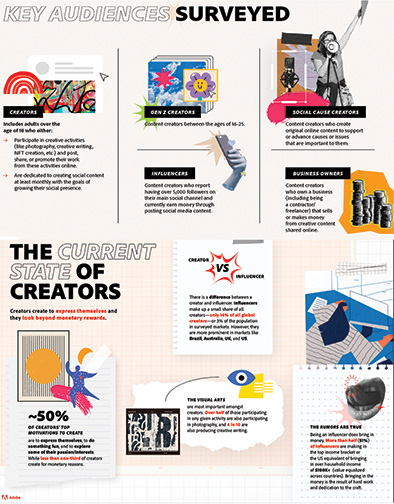
San Jose CA—Adobe announced the latest data and insights on the creator economy based on its Adobe Future of Creativity study. The study finds the creator economy—the economy empowering people who are monetizing their content, goods and services online by leveraging their talents and passions—grew by more than 165 million creators over the past two years. Moreover, it now comprises 303 million creators globally. 
In addition, the study finds that the creator economy continues to grow. Further, it is reshaping aspects of culture and society, from the future of work to social causes and mental health.
“The unprecedented growth of the creator economy provides a platform for everyone to be a creator. Individuals, ‘soloprenuers,’ small business owners as well as content creators can now express themselves and explore creative and artistic pursuits in new ways,” said Scott Belsky, chief product officer and executive vice president, Adobe Creative Cloud.
Adobe Future of Creativity Study Details
The study provides a comprehensive view into the global creator economy. It looks at how creativity is changing across the U.S., U.K., Spain, France, Germany, Australia, Japan, South Korea and Brazil. 
Furthermore, it defines creators as professionals and nonprofessionals creating original content for their jobs or passions. They include designers, photographers, filmmakers, illustrators, hobbyists and more. What’s more, influencers are a subset of creators defined as those with 5,000 followers or more who leverage social media to influence their audience.
The study reveals that since 2020, the creator economy has grown exponentially.
- More than 165 million creators joined the creator economy since 2020, with significant growth across all markets.
- In the U.S. alone, it grew by 34 million new creators (40%). Brazil (+73 million new creators), South Korea (+11 million) and Spain (+10 million) also emerged as hot spots for creativity.
- One in four people (23%) are creators contributing photography, videography, creative writing, etc., to online spaces; including social media and blogs.
- Millennials represent 42% of the creator economy. By comparison, gen Z represents 14%.
- 48% of creators are universally motivated by the same goal: freedom of expression. Less than one-third of creators (26%) are motivated by money.
- Influencers make up only 14% of the global creator economy.
Work & Activism Trends
Adobe also believes the creator economy has unlocked new full- and part-time professional opportunities. In particular, gen Z and millennials are drawn to less traditional careers. The study also found that content creation can be a source of income; however, it takes time and commitment to obtain success. While it remains a side hustle for most, many creators aspire to do more.
- Two in five influencers were motivated to start creating by the possibility of turning it into a career.
- 17% of creators are business owners; 39% aspire to become a business owner.
- For the majority of creators, creating is a hobby or side hustle. Six in 10 have full-time jobs.
In addition, the study found that creators embrace the opportunity to advance conversations around social causes online. They will also take action to support ones that are important to them personally.
- Nearly all (95%) creators take action to advance or support causes that are important to them.
- Food and housing security (62%), social justice (59%) as well as climate change (58%) top the list of causes most important to creators globally.
- By using their creativity and influence to advance social causes, creators believe they can drive awareness (51%); give a voice to those who otherwise wouldn’t have one (49%); and make it easier to voice opinions on social causes (47%).
Creators and Mental Health
Moreover, the study revealed the more time creators spend creating and sharing content, the happier they feel. This is the opposite of social media consumers. Studies have shown those consumers can experience negative effects from social media use. 
- Creators who make daily content and/or spend 10+ hours per week creating report being happiest overall.
- Most creators (69%) and influencers (84%) say creating and sharing online content is a creative outlet they can’t find elsewhere.
- One in two influencers say using social media or creating social content is more important to their mental health than listening to music (31%), exercising (30%) and going outside in nature (27%).
Methodology
The Future of Creativity study surveyed ~9,000 online creators in May 2022, in nine global markets (U.S., U.K., Spain, France, Germany, Australia, Japan, South Korea and Brazil). Adobe partnered with Edelman Data & Intelligence to conduct the study as well as analyze data to identify key trends across the creator economy.
“Creators” are defined as having participated in creative activities (e.g., photography, creative writing, original social media content creation, etc.) and posting, sharing or promoting their work from these activities online at least monthly with the goal of growing their social presence.
Data was collected from 4,535 gen-pop creators (ages 18+, ~500 per market) and 5,111 gen Z creators (ages 16–24, ~500 per market). There was a ±1.4% margin of error and 95% confidence level.
Adobe’s study, Future of Creativity: Creators in the Creator Economy, can be found here.





